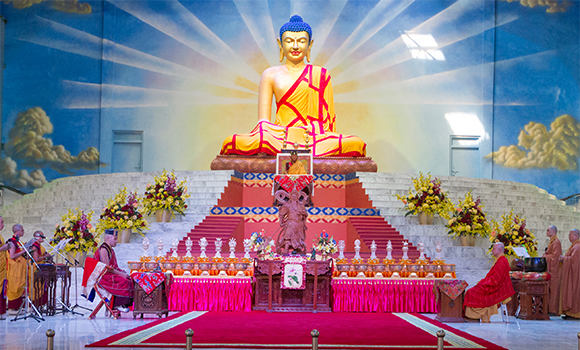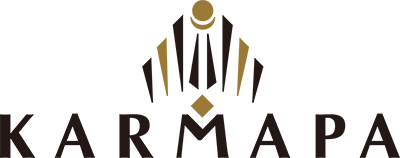
11 February, 2016 -Monlam Pavilion,
This morning, continuing a centuries-old tradition, the Gyalwang Karmapa and Venerable Master Hai Tao from Taiwan officiated at a ritual for Sangharama, a protector deity. Also on stage participating in the ritual were nuns from Karma Drubdey Nunnery in Bhutan, and monastics from Hai Tao’s Life TV community in Taiwan. The Karmapa performs this ritual annually during the Tibetan New Year. Today was the first time the Sangharama ritual has been conducted inside the Monlam Pavilion.
The protector Sangharama, also known by the name Guan Yu or Guan Gong, is a Chinese deity and also one of the protectors of the Karmapa’s Tsurphu Monastery in Tibet.
The connection between Sangharama and the Karmapa lineage began when the 5th Karmapa, Deshin Shekpa, traveled to China at the invitation of the Chinese emperor Yung Lo of the Ming Dynasty. During his travels, the Karmapa offered many teachings and empowerments, and the emperor became a devoted student of the Karmapa. These activities were witnessed by Sangharama, a local Chinese deity who lived on a mountain. Sangharama decided to follow Deshin Shekpa back to Tsurphu Monastery in Tibet. When they arrived back at Tsurphu, Sangharama needed a place to live, and so the Karmapa offered him one of the mountains behind Tsurphu Monastery. This mountain became known as “the mountain of the Chinese deity,” and Sangharama became one of the protectors of Tsurphu Monastery.
Sometime later, the Karmapa began the tradition of offering a practice for the Sangharama protector on the 2nd day of Losar each year. Because Sangharama is a mundane protector, the ritual would not be done inside the shrine hall, and instead would take place each year on the veranda outside the shrine hall at Tsurphu Monastery. The Karmapa and his retinue, such as his close attendants and cook, would perform the ritual. Because Sangharama came from China, many elements of the ritual also came from the Chinese tradition, such as Chinese incense, tea, tables, and fireworks. When the 16th Karmapa, Rangjung Rigpe Dorje, fled Tibet in 1959, the Sangharama text was lost and the continuity of the practice was broken. In order to maintain this practice, the 17th Karmapa wrote a new Sangharama ritual, which was the one performed today.
The Monlam Pavilion was transformed with many decorative elements from both Tibetan and Chinese culture. New thangkas depicting the Karma Kagyu lineage masters were hung facing the center of the hall. Behind the thangkas, facing outward, were long banners with Chinese paintings and calligraphy. In front of the central Buddha image, a small table was set with two tall candles and a bowl, all in the Chinese style. In front of the Buddha, a life-like statue of the 16th Karmapa sat on a throne, also with a Chinese-style table with offerings set in front of him. In the center of the stage stood a 4-foot wooden statue of Sangharama, and on either side of him nearly identical altars were set out with water offering bowls. The left altar included images of the Eight Auspicious Symbols, and the right the Eight Precious Offerings.
The ritual and many elements on the stage were mirrored too, with the Tibetan Buddhist and Chinese Buddhist traditions each represented. On the left side, a chair and table with a bell and dorje were set out for the Karmapa, and cymbals for the chant leaders. On the right side, a similar table and chair was set for Master Hai Tao, as well as instruments used in the Chinese Buddhist tradition for the chant leaders, such as a wooden fish and keisu (metal gong shaped like a large bowl). Near the front of the stage on the left side was a large metal bell and hanging gong in the Chinese style, and on the right side a large drum in Tibetan style.
At the beginning of the ceremony, the Taiwanese monastics and the Karma Kagyu nuns each walked onto the stage in a long line, with the Taiwanese monastics forming rows on the right side of the stage, and the Karma Kagyu nuns forming rows on the left. The monastics from Taiwan wore long monastic robes in a muted yellow and brown color. The Karma Kagyu nuns wore full ceremonial dress, including yellow chögu, white boots, and chabluk [hanging brocaded bags].
The monastics from Taiwan began chanting four verses from the Diamond Sutra, during which the Karmapa and Master Hai Tao were led by two Taiwanese monks to the center of the stage. Both the Karmapa and Master Hai Tao were wearing red outer robes, slightly different in style. The Karmapa also wore his black activity crown. The two masters stood side by side in front of Sangharama, and then took their seats facing each other on the stage.
The ritual contained chanting in both Chinese and Tibetan. The prayers in Chinese were led by the monastics from Taiwan, and the prayers in Tibetan by the nuns from Karma Drubdey Nunnery. Some of the prayers in Chinese included prostrations to Lokeshvara, taking refuge and generating bodhichitta, and praises to Sangharama. Prayers in Tibetan included self-visualization and invitation of the guests, smoke offerings, request to depart, and auspicious prayers, among others. The chanting in each language was supported by the unique melodies and instruments of the different traditions. The prayers, in Tibetan or Chinese with English phonetics, were projected on the two large screens at the front of the pavilion, so that the monastics and the lay community could join in the offerings.
At the end of the ritual, the Karmapa and Master Hai Tao left together in procession, followed shortly afterward by the monastics who quietly walked off stage in single file.


